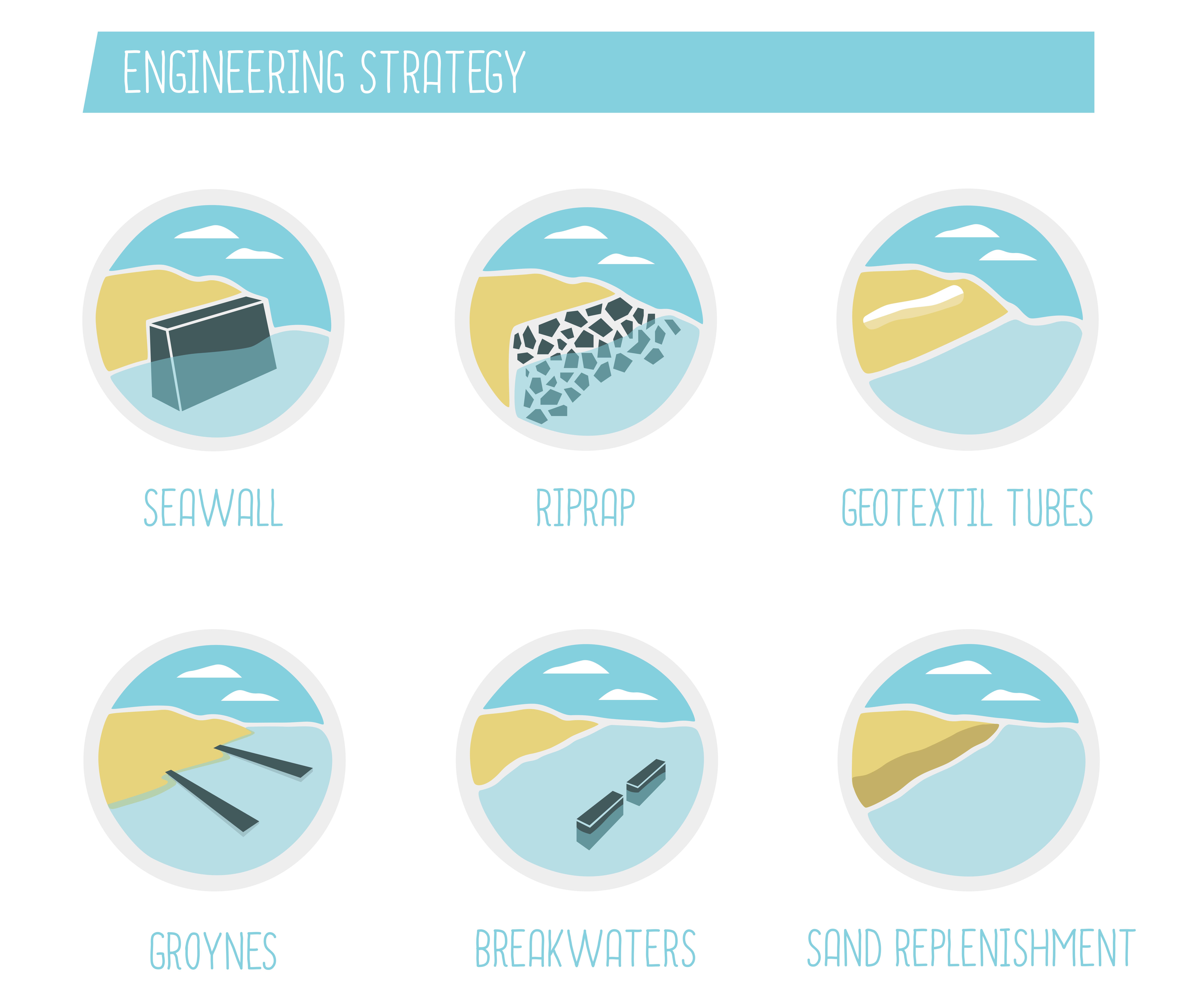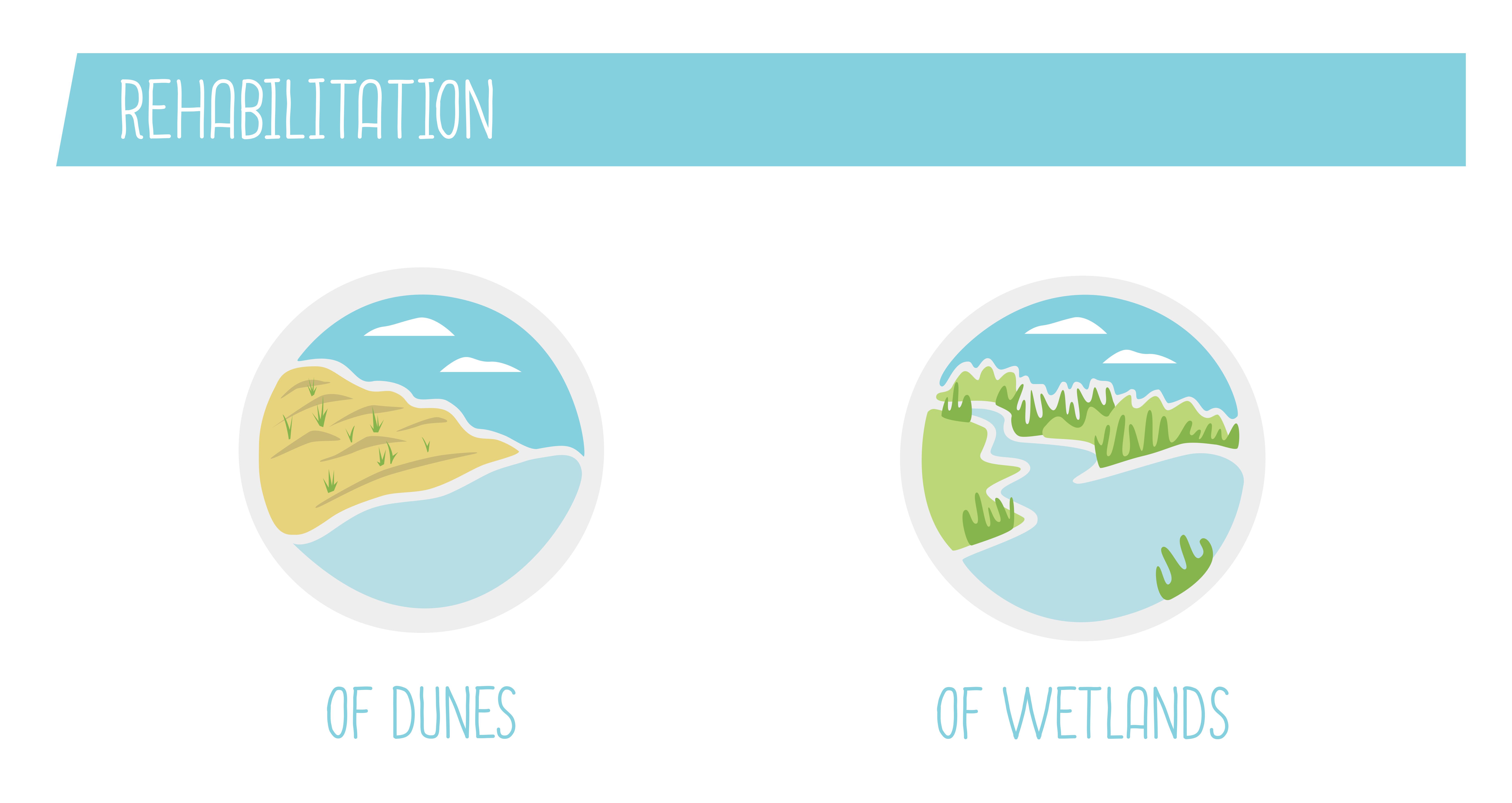Coastline management strategies
Several strategies can be used to tackle erosion and the landward advance of the sea. Each has its advantages and disadvantages. In this lesson we will look at them in detail to gain better understanding of the challenges surrounding erosion risk management. This can then help us take appropriate measures to ensure the reasonable and sustainable management of our coastal environment. To discover what strategies have been implemented on different parts of the European coast, take a look at our interactive map.
The European Commission's support for the production of this publication does not constitute an endorsement of the contents, which reflect the views only of the authors, and the Commission cannot be held respnsible for any use which may be made of the information contained therein.
Introduction
Coastlines are attractive spaces subject to a high population pressure. In UK, 36% of the people lived within 5 km from the sea and 94% within 50 km (in 2006).
They are varied territories with very different environments (beaches, cliffs, dunes, estuaries, etc.) and which are given over to a variety of uses (commercial and industrial activities; commercial and fishing ports, marinas; water sports, etc.). Also, thanks to their diversity, coastlines attract high numbers of tourists. For example, the town of Biarritz, in France, grows from 23 000 to 110 000 inhabitants during the summer season.
Nowadays, with the increasing frequency of marine weather phenomena such as storms and the population growth in coastal areas, communities are rethinking the way in which coastlines are developed.
Consequently, several strategies have been put in place in order to protect stakes on the European coast. There are four types of strategies: engineering solutions, the adaptation or support of natural processes, relocation or strategic retreat and passive monitoring.
Depending on the stakes to be protected (homes, infrastructure, natural habitats, etc.) different strategies will be favoured.
Engineering strategy
Traditionally, coastal erosion is tackled by "hard" defensive structures designed to withstand the onslaught of the sea (groynes, walls, breakwaters, etc.). These techniques can often prevent local erosion but contribute to erosion in an area near the protected zone.
In order to resolve these problems, other "soft" protection systems are being developed and offer the advantage of blending better into the natural landscape and having less of an impact on biodiversity.
1. Hard engineering methods (seawalls, groynes, riprap, etc.)
These techniques are based on two different principles:
- structures perpendicular to the coast, such as groynes, help notably to minimise the transport of sand by longshore currents (longshore drift). The beaches are replenished with sand and wave energy is dissipated.
Groyne in Westende-Bad, Belgium © Filip Bunkens / Unsplash
- structures parallel to the coast (seawalls, breakwaters, riprap, etc.) create an obstacle to the waves and stabilise the coastline.
Breakwater in Holyhead, Wales, United Kingdom © Jean Mottershead / Flickr (Creative Commons)
Disadvantages:
- Huge impact both on the landscape and on biodiversity
- Very expensive
- Partial or total disruption of leisure activities such as surfing
- Greater erosion further along the coastline (which means simply relocating the problem)
Greater erosion further along the coastline © Surfrider Foundation Europe
2. Soft engineering methods (beach nourishment, geotextile)
This strategy to combat the advance of the sea aims to dissipate wave energy and minimise changes to the ecosystem.
These techniques help to keep a dry beach at high tide, unlike the hard engineering methods. The impact on the landscape and the cost of these ‘soft’ methods are considerably lower too. Another advantage of the soft approach is that most leisure activities on the coast are not disrupted.
Beach nourishment by boat © City of Gold Coast
Beach nourishment by bulldozer © DutchWaterSector
Geotextile tubes © GlobalSynthetics
Disadvantages:
- Less sustainable and efficient over time
- Requires regular maintenance
- Beach replenishment has an impact on biodiversity
- Risk of a lack of sand (example of Lacanau, in France: for 1.2 km of coastline, the annual requirement for sand is estimated to be 72 000 m3)
Supporting natural processes
Dunes and wetlands naturally protect the coastline. Their rehabilitation or reinforcement can slow down the phenomenon of erosion and thereby reduce the risk of flooding.
1. Dune rehabilitation
For dune rehabilitation, the natural processes are supported by the installation of wooden barriers (sand fences) and the planting of vegetation which traps the sand. This prevents the sand, carried by the wind, from advancing inland. The dune is stabilised and can even gain land on the sea.
This process is slow and requires patience and specific measures to prevent people walking over the protected areas. This forces users to make detours to access the beach, but this small effort is rewarded in the long term thanks to the preservation of a healthy beach enabling users to enjoy their coastal activities.
Sand Dune restoration work in progress at Spencer Park Beach, Christchurch, New Zealand © Emma Kelland / Wikipedia (Creative Commons)
Disadvantages:
- Requires regular maintenance of the dunes and installation of essential protective structures
- Slows down the erosion process but does not stop it
- Only suitable for zones where a large dune system already exists
2. Rehabilitation of wetlands
Many wetlands on the French coastline have been dried out over recent centuries to make way for farmland or building land, to fight against the invasion of mosquitoes (the Landes forest, for example) or to facilitate access to the coast. Yet these areas act as “buffer” zones which can absorb significant quantities of water and which are capable of slowing down waves during storms. They thereby considerably reduce the risk of flooding and re-establish biodiversity.
Apart from its capacity to protect the coast, the rehabilitation of wetlands would favour the development of leisure activities such as fishing, nature observation, walks, etc. That can be a real advantage for a territory and its inhabitants, improving the living environment in keeping with a sustainable development approach.

Newtown National Nature Reserve, Isle of Wight © Wightlink
Disadvantages:
- Large areas of coastline need to be left in a natural state
- Tourist development limited to “green tourism”



